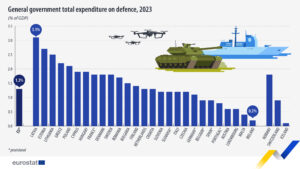Brussels – The international scenario is becoming increasingly threatening for the countries of the old continent, especially those closest to its eastern border. No wonder, therefore, that in 2023, the percentage of member states’ public spending devoted to arms, equipment, defence systems, and military aid has generally increased, reaching 2.7 per cent of total EU government spending.
Eurostat reported this, releasing this morning (March 27) the data on the military spending of the 27, taking a snapshot of the start of what increasingly looks like a twelve-star rearmament. In absolute terms, in 2023, governments spent €227 billion on defence, or 1.3 per cent of European GDP, a 12 per cent increase over the 202 billion in 2022 and 10.8 per cent over the 183 billion in 2021. Therefore, the total spending items of European chancelleries went from 2.4 per cent in 2021 to 2.5 per cent in 2022 and to 2.7 per cent in the following year in the first three years of the war in Ukraine.

Looking at individual countries, spending decisions fluctuate decisively. Devoting the largest percentage of GDP to their defence are Latvia (3.1 per cent of GDP), Estonia (2.7 per cent) and Lithuania (2.5 per cent), not surprisingly bordering Russia. They are followed by Greece (2.2 per cent) and Poland (2.1 per cent), which has made important strides in increasing the quantity and quality of its military capabilities. In contrast, Malta (0.4 per cent) and Ireland (0.2 per cent) are spending less. Notably below the 2 per cent of GDP spending target required by NATO are also France (1.8 per cent), Italy (1.2 per cent) and Germany (1.1 per cent).
Slightly less than half (42 per cent) of total defence spending in 2023 was for the payment of salaries and salaries, 29 per cent for the government purchase of goods and related services, 20 per cent in capital investment (such as the purchase of weapons, infrastructure, and vehicles), and the remaining 7.8 per cent involved capital transfers. Specifically, between 2021 and 2023, military aid increased from €8 billion to €24 billion, constituting 0.1 per cent of EU GDP, with major differences in Slovakia (1.2 per cent), Denmark (0.5 per cent), Latvia (0.4 per cent), Germany, Luxembourg, and Sweden (0.2 per cent). France, Italy, Spain and Poland, on the other hand, allocated 0.1 per cent. The smallest expenditure item was the investment in research and development, which accounted for a negligible part of national spending in all states except France (where it constituted 0.1 per cent of GDP).
English version by the Translation Service of Withub






